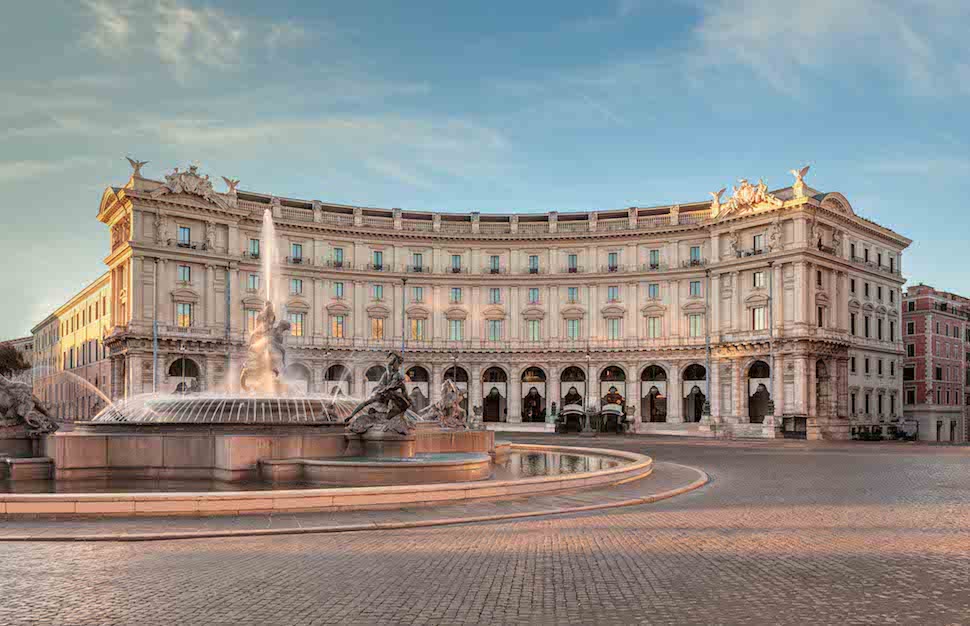
As the crown chakra with its purple hue is the body’s spiritual domain, the Anantara Spa at Anantara Palazzo Naiadi Rome occupies the hotel’s rooftop area as a sacred, curative nest that hovers above prime real estate on the grand Piazza della Repubblica. In the hotel’s lowest realms, as if it were metaphorically the hotel’s grounding earth chakra, a portion of the remains of ancient Diocletian’s Baths lie deep in the earth, showcased by a glass floor for guests to gaze upon.

The relaxation area at the spa
Together the contemporary spa, with its sleek interiors above, and the Diocletian Baths’ extant ruins below, bookend the hotel’s impressively ornate, renovated interior floors in between, replete with spacious guest rooms and common areas. A nod to the past that draws on its historical location as part of the 4th-century Diocletian Baths, Anantara Spa also salutes the future by embracing the newest technologies. Services run the gamut from old Roman-inspired rituals to the most luxurious global wellness trends.
Wellness seekers can time travel to explore treatments and ingredients similar to what ancient Romans might have enjoyed centuries ago . . .
Constructed between 298 AD and 306 AD, the Baths of Diocletian functioned as bygone Rome’s veritable living room—a health-oriented gathering place for people of all classes. The enclosure of the bath complex was spread across 32 acres. With a frigidarium (cold room), caldarium (steamy, hot room), gymnasium, tepidarium (warm room), pools, classrooms, and a library, the amazing complex held thousands of people at a time. Now part of the Rome National Museum, the baths’ main ruins, situated across the piazza from the hotel, can be visited. But upstairs at Anantara Palazzo Naiadi’s Anantara Spa, wellness seekers can time travel to explore treatments and ingredients similar to what ancient Romans might have enjoyed centuries ago. Deeply researched, Anantara Spa’s two-hour Diocletian’s Ritual recreates what a 4th-century Roman surely experienced at the baths. Composed of various steps including a sea salt scrub, a mud wrap, and an herb-infused olive oil massage, the highly satisfying treatment achieves revitalizing results sure to last . . . ad infinitum.
More on Diocletian’s Ritual

The Couple’s Suite
According to Anantara Spa’s research, the historical archives mention plants and herbs such as lavender, laurel, sage, and honey both for healing potions and religious ceremonies. Apparently, the essential ritual of the classic Roman Massage was: Lutum, Oleum, Strigilis (Mud, Oil, Strigile). The mud likely hailed from hot ponds or salt-pan extraction, since the sea sits only a few miles away from Rome. Olive oil from nearby groves was infused with herbs. Both mud and oil were scraped from the skin with an instrument called the “strigile,” a hook-shaped tool, which skilled therapists use even today to remove oil and mud simultaneously from the body, leaving the skin renewed and the muscles invigorated. For modern times, Anantara Spa combined these old-time elements into one history-packed treatment. The exfoliation for Diocletian’s Ritual uses locally-foraged sea salt, olive oil, honey, laurel, sage, and lavender. For the wrap, salt-pan mud is slathered on the body; and the grand finale, a full massage, utilizes regionally produced olive oil infused with locally grown St. John’s Wort. It simply achieves a state of scialla—the Roman word for “chill.”
How it Helps
The body scrub cleanses the skin and promotes cell renewal. The salt imparts magnesium, and smooths. Antiseptic laurel (considered sacred for clairvoyance rituals, as well) invigorates; sage is anti-inflammatory, and lavender calms. The salt-pan mud body wrap decongests detoxifies, and fights inflammation. St. John’s Wort, gathered from an artisanal herbalists, infused into the olive oil benefits injuries, calms the mind, aids insomnia, and alleviates depression.
Becca Hensley
Becca Hensley is Editor at Large for Insider's Guide to Spas. Based in Austin, she writes regularly about travel and spas. She believes a good story draws you in like laughter in a crowded room, and challenges you to do it justice. Her work appears regularly in Austin Monthly, Travel Channel, Toronto Star and National Geographic Traveler.